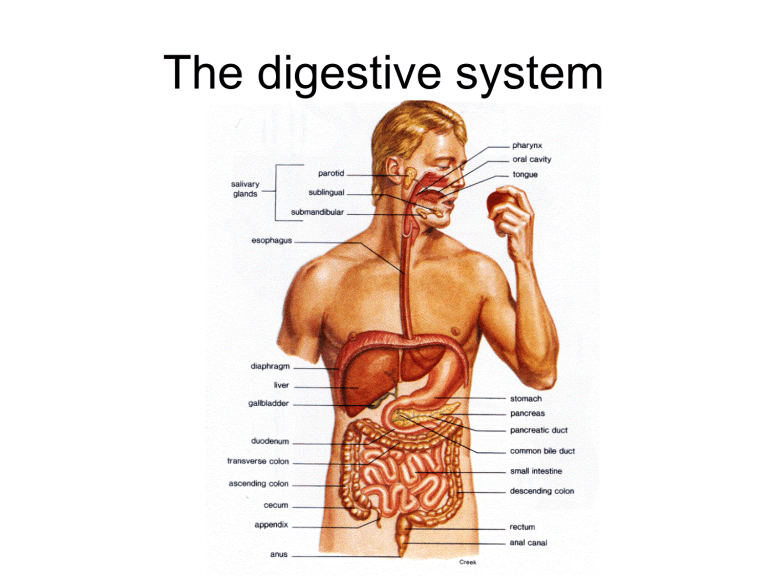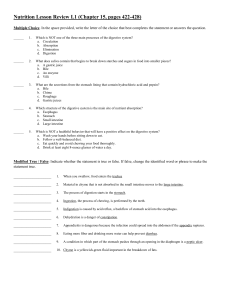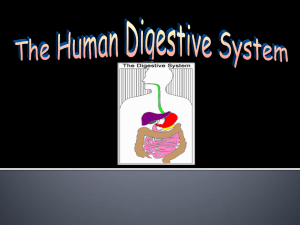
The digestive system The lumen is the cavity where digested food passes through and from where nutrients are absorbed. Both intestines share a general structure with the whole gut, and are composed of several layers. Going from inside the lumen radially outwards, one passes the mucosa, submucosa, muscle layers (made up of inner circular and outer longitudinal), and lastly serosa. Along the whole length of the gut in there are glands which secrete mucus which lubricates the passage of food along and protects it from digestive enzymes (mucosa). In the small intestine, villi are vaginations (folds) of the mucosa and increase the overall surface area of the intestine The submucosa contains nerves , blood vessels and elastic fibres with collagen that stretches with increased capacity but maintains the shape of the intestine. The next layer is a layer of smooth muscles (longitudinal and circular) that aids in the action of continued peristalsis along the gut. Lastly there is the serosa which is made up of loose connective tissue and coated in mucus so as to prevent friction damage from the intestine rubbing against other tissue. Holding all this in place are the mesenteries which suspend the intestine in the abdominal cavity and stop it being disturbed when a person is physically active Processing food 1. Ingestion- process of taking food into the digestive system so that it may be hydrolised or digested. 2. Digestion- the breakdown of food (either chemically or mechanically) in order to utilise nutrients 3. Absorption- nutrients pass from the guts to the blood stream 4. Egestion- elimination of indigested food Human digestive system Mouth • Chemical and mechanical digestion • Food is chewed (mechanical digestion) • Amylase is released within the saliva (chemical digestion) Starch to Maltose • A bolus (lump) is formed with saliva and the tongue. MOUTH Mechanical digestion Saliva (slightly alkaline) moistens the food and releases Amylase to break down Starch (chemical digestion) Swallowing (& not choking) • Epiglottis – flap of cartilage – closes trachea (windpipe) when swallowing – food travels down esophagus • Peristalsis – involuntary muscle contractions to move food along Peristalsis • series of involuntary wave-like muscle contractions which move food along the digestive tract Stomach • Food is temporarily stored here. • Gastric juices are secreted. • Has layers of muscle that line the inside. • Mechanically and chemically breaks down food. Stomach • Functions – food storage • can stretch to fit ~2L food – disinfect food • HCl = pH 2 – kills bacteria – chemical digestion • Pepsidase (enzyme breaks down proteins) But the stomach is made out of protein! What stops the stomach from digesting itself? mucus secreted by stomach cells protects stomach lining mouth break up food digest starch kill germs moisten food stomach kills germs break up food digest proteins store food sphincter sphincter Accessory Organs • Pancreas • Gall Bladder GALL BLADDER: • Pouch structure located near the liver which stores the BILE produced in the liver BILE DUCT: • Long tube that carries BILE. It connects LIVER – GALL BLADDER - DUODENUM BILE • Bile emulsifies lipids (large molecules are broken down into small droplets) so lipase can act on a larger surface area • Bile is an alkaline fluid. When discharged into the duodenum, it neutralises the acidity of the food coming from the stomach, enabling the lipase at its optimal pH. Pancreatic juice • Digestive enzymes – Proteins to peptides • Proteases – Starch to Maltose • Amylase – Lipids to Fatty acids & Glycerol • Lipase • Buffers (solutions with a highly stable pH. Adding acid or base to a buffered solution will not change its pH significantly). – They neutralise acid from stomach Small intestine • Function – chemical digestion • major organ of digestion & absorption – absorption through lining • over 6 meters! • small intestine has huge surface area = 300m2 (~size of tennis court) • Structure – 2 sections • duodenum = most digestion • ileum = absorption of nutrients & water Duodenum • 1st section of small intestine: – Receives acid food from stomach – Secretes alkaline juice – Mixes with digestive juices from pancreas, stomach, gall bladder – Secretes Maltase (maltose to glucose) – Secretes Endo/Exo - peptidases (peptidases to amino acids) Peptidases Absorption in the SI • Much absorption is thought to occur directly through the wall without the need for special adaptations • Almost 90% of our daily fluid intake is absorbed in the small intestine. • Villi - increase the surface area of the small intestines, thus providing better absorption of materials Absorption by Small Intestines • Absorption through villi & microvilli – finger-like projections – increase surface area for absorption – Epithelial cells with many mitochondria VILLI Where shall we go now??? Glucose & Amino acids Fatty acids & glycerol Through the villus epithelial layer (active transport) Through the villus epithelial layer (diffusion) To lacteal (lymph capillaries) (diffusion) To capillaries (diffusion) To thoracic duct via lymphatic system To liver via hepatic portal vein Why these differences? Glucose and amino acids are absorbed with sodium using a cotransporter as their concentration in the villi is relatively high. Sodium has to be actively removed from the cell to lower its concentration in the cell so the sodium bound with glucose and amino acids can enter. Fatty acid and glycerol its diffusion because their concentration in the villi is low, as they are immediately absorbed in to lacteal. Large Intestine • Solid materials pass through the large intestine. • These are indigestible solids (fibres cellulose). • Water is absorbed. • Vitamins K and B are secreted by ‘good’ bacteria and reabsorbed with the water. • Rectum- solid wastes exit the body (defecation).









